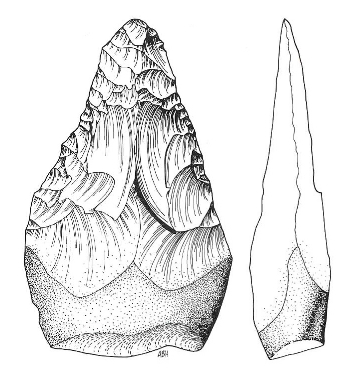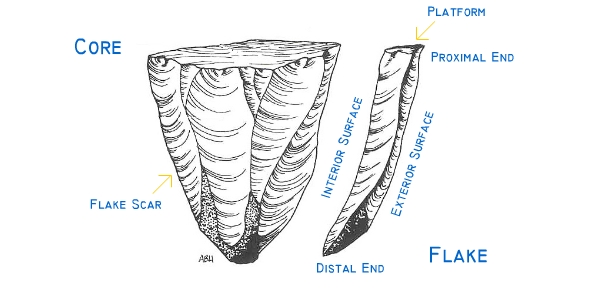|
| |
|
|
| |
Raw
materials:
Lithic, or chipped stone, tools can be made only from a few specific
types of rock, all of which are composed largely of silica (SiO2).
These rocks are either amorphous, meaning that the minerals that compose
the rocks have not formed crystals, or cryptocrystalline, meaning
that the minerals have formed patterns of microscopic crystals. Flint
and chert are cryptocrystalline, composed of tiny needlelike quartz
crystals; rhyolite and basalt can also be cryptocrystalline, composed
of larger quartz crystals combined with other nonsilica mineral crystals;
and obsidian, or volcanic glass, is composed of a combination of amorphous
silica and nonsilica minerals. Because these rocks are not composed
of large crystalline minerals, they break much like common glass,
yielding conchoidal fractures.
A
conchoidal fracture is one in which the fracture surfaces are curved.
When the rock is struck the energy of the blow is distributed evenly,
in a radial fashion, away from the point of contact. This property
of fracturing conchoidally is what makes the production of lithic
tools possible.
|
| |
Definitions:
The practice of producing lithic tools is generally termed flintknapping.
Initially, a stone, the core, is struck, to break off smaller pieces,
flakes. Depending on the technology of the flintknapper, either the
core or a flake may then be worked into a finished tool. The flat
surface at the top of the flake where it was struck is called the
platform. The platform end is the proximal end of the flake; the end
where the flake terminates is the distal end. The interior surface
of a flake, i.e. the surface that was next to the core, may be called
the ventral surface; the exterior surface may be called the dorsal
surface. Concave surfaces on any stone where flakes have been removed
are called flake scars. Any of the original weathered surface of the
stone remaining on the flakes or core is called cortex. The waste
products of flintknapping, including unwanted flakes, are called debitage.
|
| |
|
|
| |
Techniques:
Due to conchoidal fracture properties, flakes and cores tend to have
distinctive characteristics that vary with the flintknapping techniques
used to produce them. The three most common techniques are (1) hard
hammer percussion, (2) soft hammer percussion, and (3) pressure flaking.
Note that with any technique, because the interior surface of the
flake and the corresponding surface of the core or unfinished tool
were created by a single fracture, all of the characteristics of flakes
also appear in an exact negative impression on the core or unfinished
tool.
Hard
hammer percussion is the earliest and most basic flintknapping
technique, producing flakes by striking another stone, the hammerstone,
against a core. It can be used to produce finished, but simple,
lithic tools from cores, such as the early handaxes used by Homo
erectus, or as a starting point for more elaborate tools formed
either from cores or flakes. A flake struck using hard hammer
percussion frequently has a crushed area on the platform called
a point of percussion. Beneath this on the interior surface of
the flake, there will be a swelling, called the bulb of percussion,
caused by the force of the striking blow. Sometimes a chip, called
an erailleur scar, is knocked off of the bulb of percussion by
the blow. Beneath the bulb of percussion, the force of the blow
may have created ripples in the fracture which center around the
bulb of percussion.
|
| |
|
|
| |
Soft
hammer percussion produces flakes by striking the unfinished tool
with a soft hammer, usually a piece of antler, bone, or wood. A soft
hammer flake differs from a hard hammer flake in that it tends to
be thin and flat with a small platform, a lip on the interior of the
platform, and a low diffuse bulb of percussion. Because soft hammer
percussion is the easiest way to remove large, thin flakes, is particularly
useful in producing thin bifaces, or lithic tools that have been worked
on both sides.
|
| |
|
|
| |
Pressure
flaking produces flakes by using a flaker made of a soft material,
such as antler, bone, wood, or copper to apply force by pressing rather
than striking. Pressure flakes are small and fragile, and are used
to thin and shape lithic tools. Many lithic tools are produced by
a combination of all three techniques, with hard hammer percussion
followed by soft hammer percussion and then finished by pressure flaking.
|
| |
|
|
| |
Illustrating
Stone Tools:
Aside from actually flintknapping,one of the best ways to understand
the structure of a stone tool is to illustrate it. Not only will this
increase your understanding of stone tools, it is also an extremely
useful skill for an archaeologist. Because visual representations
of stone tools are highly representational, even someone with limited
artistic ability should be able to draw a decent illustration that
accurately portrays the structure of the tool.
 Lithic
illustrations follow a set of conventions that enables the viewer
to see the structure of the tool. An accurate outline of the tool
is drawn first, using calipers or another measuring device and frequently
aided by a scanned image of the tool. Next, the outlines of the flake
scars are drawn in, attention being paid to the shape of the scar
and its boundaries. There may be much variation in the size and shape
of the flake scars, ranging from hard and soft hammer scars that can
reach across an entire surface to tiny pressure flaked edge scars.
Note that flake scars almost invariably begin at the edge of the tool,
but, as earlier scars are overlain and covered by later scars, the
earlier scars may appear to originate somewhere in the center. Both
the outline of the tool and the outline of the flake scars are drawn
with a heavy line. Once
the outlines of the flake scars are drawn in, ripples from the force
of the blow are added in lighter lines. These enable the viewer to
determine how the flake fracture progressed through the tool. Any
cortex that is present will also be drawn in as a region shaded by
stippling, or dotting. Lithic
illustrations follow a set of conventions that enables the viewer
to see the structure of the tool. An accurate outline of the tool
is drawn first, using calipers or another measuring device and frequently
aided by a scanned image of the tool. Next, the outlines of the flake
scars are drawn in, attention being paid to the shape of the scar
and its boundaries. There may be much variation in the size and shape
of the flake scars, ranging from hard and soft hammer scars that can
reach across an entire surface to tiny pressure flaked edge scars.
Note that flake scars almost invariably begin at the edge of the tool,
but, as earlier scars are overlain and covered by later scars, the
earlier scars may appear to originate somewhere in the center. Both
the outline of the tool and the outline of the flake scars are drawn
with a heavy line. Once
the outlines of the flake scars are drawn in, ripples from the force
of the blow are added in lighter lines. These enable the viewer to
determine how the flake fracture progressed through the tool. Any
cortex that is present will also be drawn in as a region shaded by
stippling, or dotting.
|
| |
Exercise:
|
| |
|
|
| |
| Lithic illustrations modified from published
drawings by Amy Henderson in Whittaker, J.C. 1994. Flintknapping.
University of Texas Press, Austin. Diagrams modified from same source.
Handaxe photo from Bordaz, J. 1958. Tools of the Old and New Stone
Age. The Natural History Press, Garden City, New York. For more information
on how to illustrate lithic tools for publication see Addington, L.R.1986.
Lithic Illustration. University of Chicago Press, Chicago. |
| |
|





 Lithic
illustrations follow a set of conventions that enables the viewer
to see the structure of the tool. An accurate outline of the tool
is drawn first, using calipers or another measuring device and frequently
aided by a scanned image of the tool. Next, the outlines of the flake
scars are drawn in, attention being paid to the shape of the scar
and its boundaries. There may be much variation in the size and shape
of the flake scars, ranging from hard and soft hammer scars that can
reach across an entire surface to tiny pressure flaked edge scars.
Note that flake scars almost invariably begin at the edge of the tool,
but, as earlier scars are overlain and covered by later scars, the
earlier scars may appear to originate somewhere in the center. Both
the outline of the tool and the outline of the flake scars are drawn
with a heavy line. Once
the outlines of the flake scars are drawn in, ripples from the force
of the blow are added in lighter lines. These enable the viewer to
determine how the flake fracture progressed through the tool. Any
cortex that is present will also be drawn in as a region shaded by
stippling, or dotting.
Lithic
illustrations follow a set of conventions that enables the viewer
to see the structure of the tool. An accurate outline of the tool
is drawn first, using calipers or another measuring device and frequently
aided by a scanned image of the tool. Next, the outlines of the flake
scars are drawn in, attention being paid to the shape of the scar
and its boundaries. There may be much variation in the size and shape
of the flake scars, ranging from hard and soft hammer scars that can
reach across an entire surface to tiny pressure flaked edge scars.
Note that flake scars almost invariably begin at the edge of the tool,
but, as earlier scars are overlain and covered by later scars, the
earlier scars may appear to originate somewhere in the center. Both
the outline of the tool and the outline of the flake scars are drawn
with a heavy line. Once
the outlines of the flake scars are drawn in, ripples from the force
of the blow are added in lighter lines. These enable the viewer to
determine how the flake fracture progressed through the tool. Any
cortex that is present will also be drawn in as a region shaded by
stippling, or dotting.